#shoshone-bannock
Explore tagged Tumblr posts
Text

LaNada War Jack on the February 1970 cover of Ramparts magazine
#lanada war jack#lanada means#activist#1970#indigenous#ramparts magazine#retro magazines#indigenous american#shoshone-bannock#shoshone bannock#shoshone#indigenous peoples' day#indigenous peoples day#boots#indigenous beadwork
38 notes
·
View notes
Text
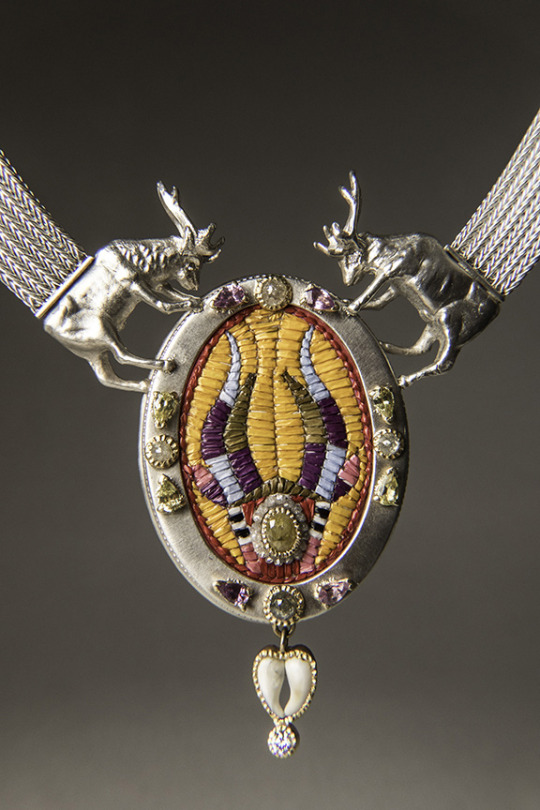

Elk Necklace collaboration between Keri Ataumbi & Jamie Okuma
#Keri Ataumbi#Kiowa#Jamie Okuma#Luiseño#Shoshone-Bannock#Wailaki#Okinawan#Jewelry#Silver#Quill Work#beadwork#Elk#contemporary art#indigenous art
19 notes
·
View notes
Text

Shoshone Bannock dancer, United States of America, by Idaho Falls Magazine
#shoshone#bannock#united states of america#america#north america#folk clothing#traditional clothing#cultural clothing#traditional fashion
746 notes
·
View notes
Text

Native Americans in Full Ceremonial Dress....1897
Ralph Willet (Bannock Tribe) & Peter Jim (Shoshone Tribe)
6 notes
·
View notes
Text
Woah omg the ranger next door to me is sharing his WiFi with me so suddenly I have Internet again
I'm in Yellowstone! I spent the week back in uniform! Who the hell told all these people there's a national park here?!




From top left: Turban Geyser while waiting for a Grand eruption, Grotto Geyser in eruption, Black Sand Pool, Ear Spring with Old Faithful erupting in the background
Tukudika Sheepeater, Shoshone-Bannock, Blackfeet, Nez Perce, Kiowa, Crow, and 21 other sovereign tribes' native land
399 notes
·
View notes
Text

Christian Allaire at the Met Gala 2024, wearing custom outfit by Jamie Okuma.
Allaire, a fashion writer at US Vogue, is Ojibwe, and a member of the Nipissing First Nation, Ontario. Okuma is a Luiseno, Shoshone-Bannock, Wailaki, and Okinawan who is also an enrolled member of the La Jolla band of Indians in Southern California where she lives and works.


Allaire: 'I knew I wanted to wear an Indigenous designer to the Met this year. When I heard this year’s theme—“Sleeping Beauties”—and dress code—“The Garden of Time”—I was instantly struck by a few concepts: That our Indigenous designs & craftwork have persisted FOREVER, and that many of our traditional garments have always beautifully reflected the natural world that surrounds us.
On the blazer, @j.okuma used a hand-reverse appliqué method to illustrate two of my favorite flowers from back home: Lupines and Indian Paintbrushes. Turns out, these flowers are also popular in Jamie’s region down on the West Coast. (We both agreed they are very “rezzy flowers.” 😉) For the pants, Jamie also put a contemporary twist on a traditional breechcloth, instead adding a built-in panel to formal tailoring. I absolutely adore how she mixed the old with the new.
To finish off the look, Jamie also surprised me with a special Bandolier-style bag that made me super emotional when I unboxed it. She found an ANTIQUE piece of Ojibwe floral beadwork (likely turn of the century) to represent my specific heritage, and then helped restore it into a cross-body style—adding modern touches like crystal straps and ribbon embellishments.
Many archival photos show Ojibwe men wearing similar Bandolier bags throughout history, and when I carried it last night, I couldn’t help but feel like I was carrying a piece of my ancestors with me. And holllah - we made it to the MET.'
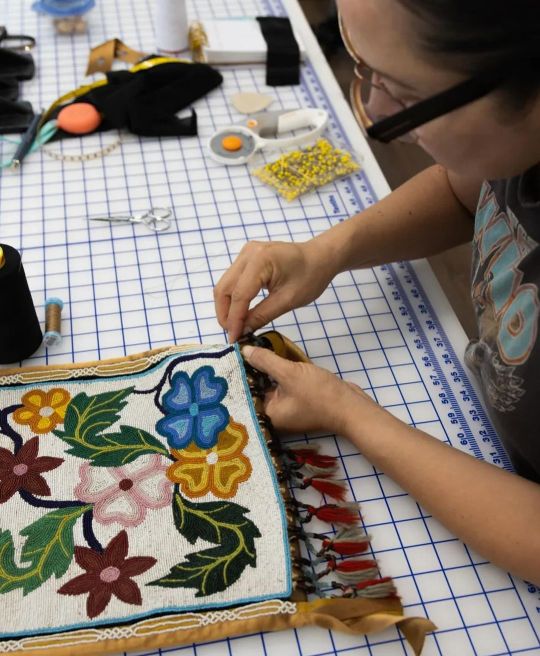
#christian allaire#met gala 2024#met gala#red carpet#fashion#indigenous designer#indigenous fashion#the garden of time#j.okuma#jamie okuma#applique#surface pattern#surface pattern design#pattern#pattern design#textiles#beadwork#beading#2024#ojibwe#flowers#floral#lupin#indian paintbrush#first nations#traditional dress#traditional craft#breechcloth#bandolier#bag
32 notes
·
View notes
Text
Excerpt from this story from The Revelator:
The first time I visited Peehee Mu’huh, mining for lithium had already begun.
I was there in the fall of 2023 as part of my work with People of Red Mountain, descendants of the Fort McDermitt Paiute-Shoshone Tribe who lead the movement against extraction on this sacred landscape. We gathered at the valley in northern Nevada, known as Thacker Pass, to commemorate the massacre of 31 Paiute-Shoshone people there by the U.S. Cavalry on Sept. 12, 1865.
To dig up every pound of lithium, the mine will remove thousands of pounds of rock, soil, and other minerals, most of which will not be used and are considered waste.
That’s the secret of mining: It requires significant space to dump its byproducts.
Mine waste is no longer in the forefront for the environmental movement as it was when coal and nuclear power had their heyday, but it remains a key issue activists and scholars should be following. At Thacker Pass the 1,300 acres of wasteland will occupy the space indefinitely. Arsenic, antimony, and other hazards from the refining process to get lithium from the clay will pile up in this backfill pit and leach into the soils, watersheds, and air.
Historically miners have faced minimal oversight. Any individual could venture onto public lands and stake a claim to the minerals they contained — rights to occupy the land were established merely by proving a mineral’s presence and getting there first. Unlike loggers on public land, miners don’t pay any royalties; mine leases on public lands cost as little as $3 dollars per acre.
You might be forgiven for thinking this scenario sounds like something out of the 1800s prospector and ‘49ers era — and in fact, it is. Mining law was last meaningfully legislated under the 1872 General Mining Act.
Just as with the Black Hills gold rush in the Dakota Territory and those in Oregon and California, mine fervor during the gold and silver rushes that white settlers led on the red-colored mountains of Paiute-Shoshone lands in the 1850s-60s was violent and met by Indigenous resistance.
That resistance was crushed. Many noncombatants were killed and others forcibly displaced to Washington; the destruction continued for decades and hasn’t stopped yet.
Today the land base of the Paiute, Shoshone, and Bannock peoples of the area — collectively known as Atsawkoodakuh wyh Nuwu or Red Mountain Dwellers — is permeated by both abandoned and active mines. Gold and tungsten mining waned in the early to mid-1900s, but then companies started extracting uranium and mercury at the McDermitt and Cordero mines across the road from Fort McDermitt. According to Department of the Interior archives, this was the nation’s largest mercury mine from the 1930s to the 1970s. After the Cordero mine closed, crews spread arsenic-contaminated waste from the mine around the town and reservation as a fill dirt. The region was later declared a Superfund site, and the contaminants were removed between 2009 and 2013.
But the toxic waste caused decades of harm in the community before that removal. In a brazen environmental injustice, many Tribal members who worked there perished of cancer. Sunoco and Barrick Gold, the companies that exploited the quicksilver lode, simply “declined” the EPA’s order to clean up the area and escaped culpability.
Now the sacred landscape of Peehee Mu’huh will become the country’s largest lithium bounty.
A new bill before Congress aims to strip away even the baby-steps reform of Rosemont. The Mining Regulatory Clarity Act (HR2925) passed the House in May and awaits Senate approval (S1281). One would assume a bipartisan effort with such a name would offer progress, but the bill guts Rosemont by removing the requirement of claimants to prove minerals before using and dumping waste on public land.
A competing bill, the Green Energy Minerals Reform Act, would introduce requirements such as paying mineral royalties and funding cleanup — basic protections that should have already been in force. Congress held hearings about this proposed legislation in late 2023, but it has not moved forward since.
16 notes
·
View notes
Text
Tribes in Nevada Honor Victims of Cavalry Massacre
Commemoration Highlights Need to Respect Indigenous Communities’ Rights

On September 21, I attended the fourth annual commemoration of a massacre at Peehee Mu’huh, land sacred to People of Red Mountain (Atsa Koodakuh wyh Nuwu) in northern Nevada. During the commemoration, tribe members and their supporters gathered at Sentinel Rock in the McDermitt Caldera to celebrate community and honor the ancestors who died there on September 12, 1865, when the United States Cavalry murdered elders, women, and children and left their entrails spread across the sagebrush.
At the commemoration, I watched as the knowledge keepers and descendants of the Fort McDermitt Paiute, Shoshone, and Bannock Tribes sang the songs of their people and threw cedar, tobacco, and sage into the fire. People of Red Mountain and other Native people use this land to hunt animals and gather plants for food and medicine. The commemoration was an opportunity to gather and worship the sacred land and spirits who occupy it, and to honor both the memory of those the US military massacred and all who carry their memory forward.
A lithium mine is also under construction at Peehee Mu’huh, signaling a tension between the present, the past, and the future.
The memory of the Peehee Mu’huh massacre is a stark reminder of the violent forces and brutal federal policies that have shaped colonialism in the United States.
People of Red Mountain remain dedicated to honoring the legacy of their people. “There are three things they can never take away from us: our medicine, our prayer, and our song,” said Ray Bacasegua Valdez of the American Indian Movement.
7 notes
·
View notes
Text

BANNOCK / SHOSHONE MAN ...
C. 1896
9 notes
·
View notes
Note
hey! first of all, free palestine! i know you are taking part in the protest here on tumblr, so i imagine this will only be answered after the 25th.
i am looking for polynesian female fcs in their 40s. could you help? thanks in advance!
Rachel House (1971) Ngāti Mutunga, Ngāi Tahu, White.
Deborah Mailman (1972) Te Arawa, Ngāti Porou, Bidjara.
Nikol Kollars (1973) Kānaka Maoli, Chinese, White.
Kaliko Kauahi (1974) Kānaka Maoli, Japanese.
Monica Galetti (1975) Samoan.
Teuila Blakely (1975) Samoan.
Keala Settle (1975) Ngāti Kahungunu Maori, Ngāi Tahu Maori, Rangitāne o Wairau Maori, Ngāti Raukawa Maori / White.
Simone Kessell (1975) Ngāti Tūwharetoa, Ngāi Te Rangi / White.
Miriama Smith (1976) Te Arawa.
Jamie Okuma (1977) Shoshone, Bannock, Luiseno, Kānaka Maoli, Ryukyuan.
Shannyn Sossamon (1978) Kānaka Maoli, Filipino, White.
Shavaughn Ruakere (1978) Te Āti Awa.
Tamina Snuka (1978) Samoan, Fijian.
Bic Runga (1979) Ngāti Kahungunu, Malaysian, Chinese.
Anapela Polataivao (1980) Samoan.
Stacey Leilua (1982) Samoan, Unspecified Māori, Unspecified White.
Lei’D Tapa (1982) Tongan.
Aaradhna (1983) Samoan / Gujarati Indian.
Thank you so so much for understanding that this would be posted later, it's now the 25th here so I'm replying and I hope this helps!
4 notes
·
View notes
Text


Pocahontas set 2014
Collaboration between Keri Ataumbi & Jamie Okuma
Yellow gold, brilliant cut diamonds, silk knotted pearl strings with indigenous wampum, and fresh water pearls surround miniature portraits of Pocahontas. This set was purchased by the Minneapolis Institute of Art.
#Keri Ataumbi#Kiowa#Jamie Okuma#Luiseño#Shoshone-Bannock#Wailaki#Okinawan#Jewelry#contemporary art#indigenous art#Gold#Diamonds#Pearls#Wampum#Wampum Beads#Beaded Portrait
7 notes
·
View notes
Photo




JAMIE OKUMA - shoshone, bannock, luiseno, kanaka maoli, ryukyuan
Credit - moore
|| native challenge by @monoclegraphic
#jamieokuma#jamie okuma avatars#rpg ressources#avatars 400x640#fc#faceclaim#rp#rpg#rpg avatars#avatars rpg#avatars#native challenge#inclusive#poc
13 notes
·
View notes
Text
WHO AM I (?)
HEYO! I AM:
—An aroace agender self-diagnosed autistic furry icon —A Native American (Shoshone-Bannock Tribes) —A voracious reader (and seldom writer)
MY CURRENT FANDOM(S):
—Loonatics Unleashed (Tech x Rev)
MY BLORBOS:
—Rev Runner (my beloved <3, Loonatics Unleashed) —Tech E. Coyote (Loonatics Unleashed) —Danger Duck (Loonatics Unleashed) —Daffy Duck (literally me, Looney Tunes)

MY TOP 5 FAVORITE BOOKS:
—Invisible Man - Ralph Ellison —The Brothers Karamazov - Fyodor Dostoyevsky —Beloved - Toni Morrison —A Grain of Wheat - Ngũgĩ wa Thiong'o —Go Tell It on the Mountain - James Baldwin

MY TOP 5 FAVORITE MOVIES:
—Moonlight —The SpongeBob SquarePants Movie —Come and See —Do The Right Thing —Yi Yi
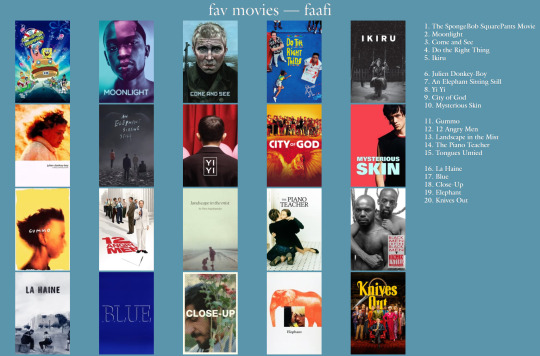
*check out the trigger warnings for each film before watching
MY TOP 10 FAVORITE ALBUMS (because 5 wasn’t enough):
—Lift Your Skinny Fists Like Antennas to Heaven! - Godspeed You! Black Emperor —Knife Man - AJJ —Islands - King Crimson —Laughing Stock - Talk Talk —Wild Is the Wind - Nina Simone —Not Available - The Residents —Pink Moon - Nick Drake —Donuts - J Dilla —SINNER GET READY - Lingua Ignota —The Steven Wilson Remixes - Yes

And that's (partially) me! I am looking forward to being a bozo on here :3

9 notes
·
View notes
Text


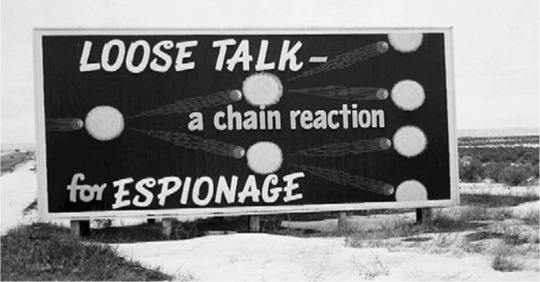
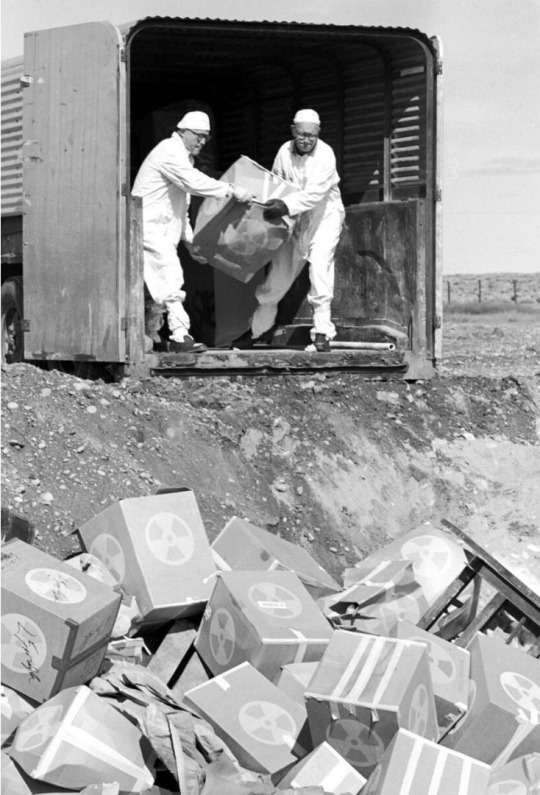
Hanford Nuclear Reservation 1944-1987

Part of the Manhattan Project, the Hanford site is the worlds first full-scale nuclear reactors that generated two thirds of the plutonium generated in the US. The operation resulted in tanks of toxic, radioactive sludge near the banks of the Columbia river, on of Americas largest rivers. Over time, improper storage resulted in leaching of over 60 different radionuclides. Hanford contains 60 percent of the nation’s high-level radioactive waste and is considered by many to be one of North America’s most contaminated nuclear sites.
Potential pathways of uptake for radionuclides in the area are present in sediments, soil, waters, and in the wildlife. While concentration of radionuclides flux in the Columbia River, on average 300,000 curies of activity is discharged per year. Benchmark for radionuclide exposure is 1 rad/year. Biota in the area were measured in 1992 by the DOE's contracted laboratory observed salmon eggs exposed to 0.00443 rad/d, 0.73 rad/d for the highest exposed fish and 1 rad/d for plant eating ducks. Most reproductive effects for adult fish are observed at 0.4 rad/d.
Once its closure in 1987, the Hanford site was placed in the National Priorities list in 1989. In 2003, the Department of Energy made an effort to reclassify all waste at the Hanford site in order to have no oversight by the EPA, states of Washington and Oregon, or by the Yakama Nation. Yakama Nation, the Shoshone-Bannock tribes, and the Snake River Alliance together sued the DOE and won: Courts noted that only Congress has the authority to reclassify waste. Though, in 2019 the DOE “reclassified” the toxic nuclear waste in Hanford’s tanks without any oversight by the U.S. EPA, the state or by the Yakama Nation, contradicting explicit directions of the Nuclear Waste Policy Act passed by Congress in 1982 and violating the Yakama treaty.
Though it is estimated to cost $240 billion to clean up the site by the US Government Accountability Office, as of 2009 over $100 Billion have been invested in the site to remove/replace leaky storage tanks.
3 notes
·
View notes
Text
Applying risk and reliability analysis across industries
New Post has been published on https://thedigitalinsider.com/applying-risk-and-reliability-analysis-across-industries/
Applying risk and reliability analysis across industries
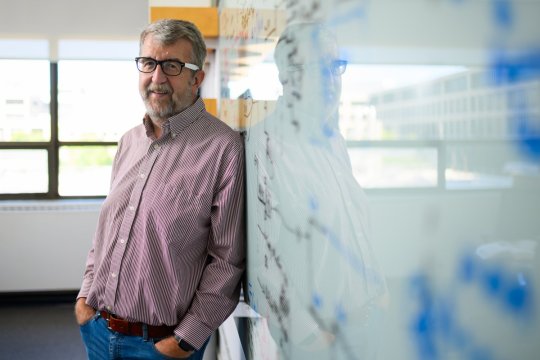

On Feb. 1, 2003, the space shuttle Columbia disintegrated as it returned to Earth, killing all seven astronauts on board. The tragic incident compelled NASA to amp up their risk safety assessments and protocols. They knew whom to call: Curtis Smith PhD ’02, who is now the KEPCO Professor of the Practice of Nuclear Science and Engineering at MIT.
The nuclear community has always been a leader in probabilistic risk analysis and Smith’s work in risk-related research had made him an established expert in the field. When NASA came knocking, Smith had been working for the Nuclear Regulatory Commission (NRC) at the Idaho National Laboratory (INL). He pivoted quickly. For the next decade, Smith worked with NASA’s Office of Safety and Mission Assurance supporting their increased use of risk analysis. It was a software tool that Smith helped develop, SAPHIRE, that NASA would adopt to bolster its own risk analysis program.
At MIT, Smith’s focus is on both sides of system operation: risk and reliability. A research project he has proposed involves evaluating the reliability of 3D-printed components and parts for nuclear reactors.
Growing up in Idaho
MIT is a distance from where Smith grew up on the Shoshone-Bannock Native American reservation in Fort Hall, Idaho. His father worked at a chemical manufacturing plant, while his mother and grandmother operated a small restaurant on the reservation.
Southeast Idaho had a significant population of migrant workers and Smith grew up with a diverse group of friends, mostly Native American and Hispanic. “It was a largely positive time and set a worldview for me in many wonderful ways,” Smith remembers. When he was a junior in high school, the family moved to Pingree, Idaho, a small town of barely 500. Smith attended Snake River High, a regional school, and remembered the deep impact his teachers had. “I learned a lot in grade school and had great teachers, so my love for education probably started there. I tried to emulate my teachers,” Smith says.
Smith went to Idaho State University in Pocatello for college, a 45-minute drive from his family. Drawn to science, he decided he wanted to study a subject that would benefit humanity the most: nuclear engineering. Fortunately, Idaho State has a strong nuclear engineering program. Smith completed a master’s degree in the same field at ISU while working for the Federal Bureau of Investigation in the security department during the swing shift — 5 p.m. to 1 a.m. — at the FBI offices in Pocatello. “It was a perfect job while attending grad school,” Smith says.
His KEPCO Professor of the Practice appointment is the second stint for Smith at MIT: He completed his PhD in the Department of Nuclear Science and Engineering (NSE) under the advisement of Professor George Apostolakis in 2002.
A career in risk analysis and management
After a doctorate at MIT, Smith returned to Idaho, conducting research in risk analysis for the NRC. He also taught technical courses and developed risk analysis software. “We did a whole host of work that supported the current fleet of nuclear reactors that we have,” Smith says.
He was 10 years into his career at INL when NASA recruited him, leaning on his expertise in risk analysis to translate it into space missions. “I didn’t really have a background in aerospace, but I was able to bring all the engineering I knew, conducting risk analysis for nuclear missions. It was really exciting and I learned a lot about aerospace,” Smith says.
Risk analysis uses statistics and data to answer complex questions involving safety. Among his projects: analyzing the risk involved in a Mars rover mission with a radioisotope-generated power source for the rover. Even if the necessary plutonium is encased in really strong material, calculations for risk have to factor in all eventualities, including the rocket blowing up.
When the Fukushima incident happened in 2011, the Department of Energy (DoE) was more supportive of safety and risk analysis research. Smith found himself in the center of the action again, supporting large DoE research programs. He then moved to become the director of the Nuclear Safety and Regulatory Research Division at the INL. Smith found he loved the role, mentoring and nurturing the careers of a diverse set of scientists. “It turned out to be much more rewarding than I had expected,” Smith says. Under his leadership, the division grew from 45 to almost 90 research staff and won multiple national awards.
Return to MIT
MIT NSE came calling in 2022, looking to fill the position of professor of the practice, an offer Smith couldn’t refuse. The department was looking to bulk up its risk and reliability offerings and Smith made a great fit. The DoE division he had been supervising had grown wings enough for Smith to seek out something new.
“Just getting back to Boston is exciting,” Smith says. The last go-around involved bringing the family to the city and included a lot of sleepless nights. Smith’s wife, Jacquie, is also excited about being closer to the New England fan base. The couple has invested in season tickets for the Patriots and look to attend as many sporting events as possible.
Smith is most excited about adding to the risk and reliability offerings at MIT at a time when the subject has become especially important for nuclear power. “I’m grateful for the opportunity to bring my knowledge and expertise from the last 30 years to the field,” he says. Being a professor of the practice of NSE carries with it a responsibility to unite theory and practice, something Smith is especially good at. “We always have to answer the question of, ‘How do I take the research and make that practical,’ especially for something important like nuclear power, because we need much more of these ideas in industry,” he says.
He is particularly excited about developing the next generation of nuclear scientists. “Having the ability to do this at a place like MIT is especially fulfilling and something I have been desiring my whole career,” Smith says.
#2022#3d#aerospace#American#amp#Analysis#astronauts#background#board#career#Careers#chemical#college#Community#courses#data#Department of Energy (DoE)#earth#education#energy#engineering#engineers#Events#factor#Faculty#FBI#federal#focus#Fukushima#Future
0 notes
Text
The Owyhee Canyonlands are a vast, remote land of austere deserts and deep volcanic canyons located in southeast Oregon spanning several million acres, over two million of which have no roads.
From pronghorn, desert bighorn sheep, greater sage-grouse, mule deer, and redband trout to rare native plants, there is no shortage of special and important plants and animals in the Owyhee. Anchored by the Owyhee River, the desert, and prominent mountain high points, the unique geography offers stunning vistas, some of the darkest night skies in the U.S., and historic sites that are significant to the Northern Paiute, Bannock and Shoshone Tribes that lived here for thousands of years.
Urge Oregon Senators Wyden and Merkley to support a national monument designation to protect over a million acres of irreplaceable habitat in southeast Oregon
#enviromentalism#ecology#Owyhee Canyonlands#pronghorn#bighorn sheep#greater sage grouse#mule deer#Redband trout#oregon#national parks
0 notes